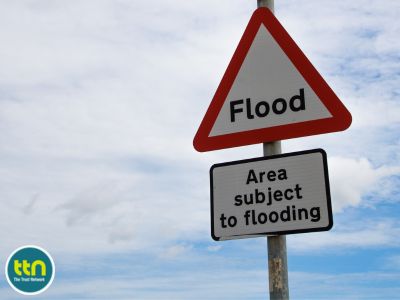
In 2015 36 schools in Cumbria faced weeks of closure and extensive clean-up operations after storms caused significant flooding. In 2021 the Government warned that nearly 15,000 schools, would be at significant risk from flooding by 2050 due to anticipated climate change. 10,700 schools, nearly half of the 21,600 schools in England, were already at risk with a further 4,000 anticipated to be added to this number. Consequently, the Government is encouraging schools to have emergency flood plans in place, as well as ensuring schools are signed up to receive weather and flood warnings.
What are the different types of flood risk?
- Coastal flooding – When the sea floods the coast during storm surges and high winds.
- Groundwater flooding – This is caused by water rising up through the ground.
- Surface water flooding – This occurs when rainwater cannot drain away through the normal drainage systems. Areas with a prevalence of harder surfaces, such as concrete, are more severely affected.
What damage can flooding do to your school?
According to the Royal Geographical Society, 2.5cm of water can damage walls, drainage, electricity, plaster, skirting boards, radiators, window frames and cellars. Whereas depths of 100cm will incur damage to gas, electrical sockets and wiring, wallpaper, kitchen units, appliances, plumbing, doors, stairs, soft furnishings, and contents.
Is your school at risk from flooding?
Areas in England that are of particular risk of flooding include, but are not limited to, the following:
- Cambridgeshire: Peterborough and Holbeach.
- Essex: Burnham-on-Crouch.
- Kent: New Romney, Gillingham, and Rochester.
- Lincolnshire: Woodhall Spa, Boston, Skegness, Scunthorpe, and Sandtoft.
- Norfolk: Great Yarmouth.
- Sussex; Adur and Arun.
You can also click on the link View map of flood warning and alert areas underneath the Search a location box to see where there are flood warnings in place in your school’s local area and what type of flooding your school may currently be at risk from eg river, sea, groundwater, or heavy rainfall. If your school is identified as being at risk, you can sign up to receive alerts at the following weblink.
The Environment Agency has produced flood maps which show the risk of river and coastal flooding. To check whether your school is at risk go to the following weblink and type in your school’s postcode.
You can also check the longer-term flood risk for an area in England by using the Government’s online service at
What should you do to prepare for a flood?
The Environment Agency has produced a Business Flood Plan Checklist (updated November 2023) which gives guidance on what to do before a flood, including checking that your insurance covers your school for flood damage, business interruption and lost revenue (e.g. from lettings). It can be accessed via:
What should you do if your school experiences a flood?
If the area in which your school is located has a severe flood warning in place where there is a danger to life, you should evacuate the premises and then turn off the gas, electricity and water supplies if it is safe to do so. For example, do not touch an electrical switch if you’re standing in water. Following this, the action you need to take will depend upon what has been affected by flooding, as follows:
| Impact of flooding | Who to contact |
| Blocked sewers and burst water mains | Your local water company |
| Public drains and flooded roads | Your local council |
| Flooding from main rivers or the sea | Environment Agency – 0800 807060 (24 hour service) |
| Groundwater flooding | Your local council |
| Surface water flooding | Your lead local flood authority (generally your local council) |
| Water building up in a road | Floodline – 0345 988 1188 |
| If you or others are in danger | Call 999 |
If your school is likely to be at risk from flooding, then ensure that you have the contact numbers listed in the table above saved on your mobile phone.
Following a flood, you should:
- Check with the emergency services that it is safe to return to the school, and ensure that your water, gas and electricity are checked by qualified engineers to ensure that they are safe before turning them back on.
- Contact your insurance company to start your claim, and to get advice on what you can move and throw away.
- Take photos of any damage and the flood water line before you start clearing up.
- Be aware that flood water may contain sewage. If so, you should contact the environmental health department at your local council for advice.
- Consult your asbestos management survey so that you are aware of any areas that have been affected by the flooding that may contain asbestos.
- Identify what measures could be put in place to reduce the impact of flooding in future.
And finally…
Schools should always:
- Refer to suitably qualified professionals for detailed advice and guidance
- Read the latest government advice – see

Register Now
Join The Trust Network FREE
